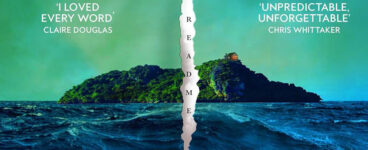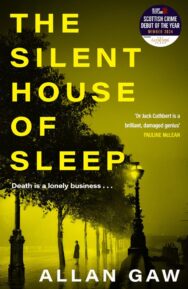‘Yes, of course, readers want intricate, absorbing plots, but they also want to read about characters who seem real and whose lives are as interesting as the world they inhabit.’
The Silent House of Sleep is the first book in a new crime series featuring Dr Jack Cuthbert. BooksfromScotland spoke to author Allan Gaw about his publishing journey so far.
The Silent House of Sleep
By Allan Gaw
Published by Polygon
Hello Allan, could you tell us about Dr Jack Cuthbert and your first novel The Silent House of Sleep?
The Silent House of Sleep is a period murder mystery set in two interwoven time periods— the late 1920s in London and the years of the First World War in Edinburgh and on the Western Front. It is the first in the Dr Jack Cuthbert mystery series.
The main character, Dr Jack Cuthbert, is a Scottish doctor working in London with Scotland Yard between the wars. Today we would call him a forensic pathologist, but at the time that term was not used.
He is a complex man — early thirties, tall and striking to look at and extremely good at his job. But, like so many men of his generation, he also bears the mental scars of his experiences in the First World War. Moreover, he lives with the closely guarded secret of his homosexuality — indeed in a world where he would be viewed as a criminal, he is so closeted that he really hasn’t come to terms with his own sexuality.
The story itself begins in 1928. When a student goes missing, not one but two bodies are unearthed, and Cuthbert is faced with one of the most baffling forensic puzzles of his career. He is working for the first time with a new, young Detective Chief Inspector at the Yard, and he knows he must come up with an explanation for what he has found. However, in solving the case, Cuthbert uncovers a nightmarish secret from his own past and realises he has brought more than memories back from the war.
It’s been a bit of a whirlwind few months for you – winning the Bloody Scotland debut prize, and your book deal with Polygon. Have your feet touched the ground yet?
The success of the book has genuinely surprised me. The genre of crime fiction is very crowded with no shortage of remarkable books written by talented authors. That my debut novel should first win the Bloody Scotland prize and then be picked up by Polygon and finally find itself as the Waterstones’ Scottish Book of the Month astonished me. I will never forget the feeling of my name being called at the award ceremony in Stirling, of the call from the publisher or of standing outside the Waterstones in Sauchiehall Street, Glasgow staring open-mouthed at an entire window display of my books. This is the stuff of writers’ dreams. So, to answer your question, no, I am still hovering pleasantly some inches above the carpet.
Your Jack Cuthbert novels are set in interwar period. What drew you to set your books at this time?
As a former pathologist it was not surprising that I should write about a pathologist — after all, we are always counselled to write about what you know. What was not a given, however, was that I should set my book in the 1920s and 30s. I did this for several reasons. First, I was keen to escape the contemporary world in my writing. People read books as a form of escapism; sometimes people write them for the same reason. Second, that period is for me a fascinating one. It is a time of great change, with a lot of emerging science and technology that is just beginning to have a real impact on forensic pathology. As a result, there were a lot of interesting possibilities to explore. And finally, an altogether less lofty reason — I didn’t want to write a book with mobile phones in it.
How has your career as a pathologist helped you with your writing?
My medical training, and in particular my research training, has been invaluable. Throughout my career I was called upon to write a great deal. Over the decades, I was able to develop and hone the writing and research skills that I have now been able to successfully transfer to my fiction writing. And what I have discovered is that when it comes to good writing, academic, technical non-fiction and fast-paced immersive crime fiction have much in common.
Can you give us a little hint of what’s next for Jack Cuthbert as the series progresses? How do you shape the individual books while keeping a series narrative flowing too?
When I finished book 1 — The Silent House of Sleep — I knew I still had a lot to say about the characters and in particular about Dr Jack Cuthbert. So, I knew then that I was dealing with a series, where I would take the same cast of characters forward in time giving them different challenges and at the same time allowing my readers to get to know them better.
As the series unfolds, there will be different baffling crimes and new fascinating forensic puzzles for them to solve, but there will also be a whole range of new events for them to react to. As the 1920s become the 30s and hurtle toward the 40s, everything will change for these people. And along the way I will answer a whole range of questions that my readers have asked — what’s Madame Smith’s real story?, will Simon and his fiancée Sarah get married?, how will Mowbray and Cuthbert’s professional relationship develop?, and of course, will Jack Cuthbert ever find love?
As the series builds, I want to find a balance between allowing the characters to develop fully and become people we know well on the one hand, and the criminal and forensic investigations on the other. But I think you can do both. Yes, of course, readers want intricate, absorbing plots, but they also want to read about characters who seem real and whose lives are as interesting as the world they inhabit.
What are you looking forward to reading in 2025?
I read a lot of different kinds of books — fiction, non-fiction and poetry. I am particularly excited by the new Callum McSorley novel, Paperboy, which is due out in the spring. I am also eagerly awaiting two debut poetry collections that will be published this year from poets that I greatly admire — Jen Dunn (Seahorse Publications) and Matthew Keeley (Drunk Muse Press). Both authors are definitely emerging poets to watch for in the future. Oh, and there are also three further books in the Dr Jack Cuthbert series coming from Polygon this year that I’m looking forward to seeing in print.
The Silent House of Sleep by Allan Gaw is published by Polygon, priced £9.99.
ALSO IN THIS ISSUE

 Beautiful Ugly by Alice Feeney
Beautiful Ugly by Alice Feeney
‘Our adventure might have had a tricky beginning, but this is beautiful, and I experience something …

 Coorie Doon by Jackie Kay & Jill Calder
Coorie Doon by Jackie Kay & Jill Calder
‘Ilka times, her daddy sang a song Shona loved, called The Tiree Love Song’













